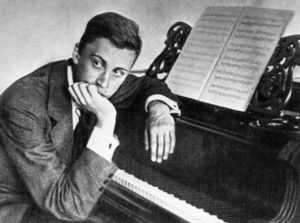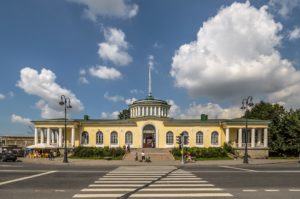On September 21, 22 and 23, 2018, world renowned piano virtuoso Yefim Bronfman returns to Houston to perform Prokofiev’s spellbinding Piano Concerto No. 2 with Music Director Andrés Orozco-Estrada and the Houston Symphony. Discover the dark backstory behind this fascinating masterpiece.

Prokofiev composed his second piano concerto at the age of 21 while on winter break from his studies at the St. Petersburg Conservatory. He had already established himself as something of a bad boy with his brilliant and original First Piano Concerto; with his second he sought to evoke darker, deeper emotions. The result is one of the most technically difficult and fascinating piano concertos in the repertoire.
Unusually, Prokofiev’s Second Piano Concerto has four movements instead of three, perhaps reflecting the composer’s expressive ambitions. The first movement begins with a dark, expansive melody that intensifies as more of the orchestra enters:
By way of contrast, this music leads to one of Prokofiev’s characteristically sardonic, teasing themes. Halfway through the movement, the orchestra falls silent as the soloist returns to the opening melody, thus beginning the movement’s monumental cadenza (a long passage for the soloist alone). The cadenza becomes increasingly virtuoso in its figuration, until at the most dissonant moment the orchestra reenters with terrifying force. The movement ends as the soloist plays a ghostly echo of the opening theme.
The fiendish second movement is a perpetuum mobile that requires the soloist to play at top speed nonstop. After this, the soloist only has about thirty seconds to rest as the orchestra begins the third movement, a grotesque march containing moments of levity that seem to mock their oppressive surroundings. The last movement begins maniacally, but after the initial chaos, Prokofiev reveals an introspective, melancholy melody (Prokofiev’s friend and fellow composer Nikolai Myaskovsky particularly admired this theme). An extensive cadenza leads to a twisted, fragmented version of the lyrical theme. After a brief moment of reflection, the madness of the opening returns, and the movement ends with a hair-raising tour de force for piano and orchestra.
One of the first people to hear Prokofiev play through his new concerto was his best friend, Max Schmidthof, a classmate who had impressed Prokofiev with his encyclopedic knowledge of music. “I played him parts of the Second Piano Concerto,” Prokofiev recalled in his diary. “He likes the third movement and especially the first movement cadenza. The Finale elicited vociferous approval; I had to repeat the opening theme three times.” Tragically, this friendship would be cut short; not long after Prokofiev completed the concerto, Max took a train to the Finnish forests and shot himself; he and his mother were in dire financial straits, and he could not pay the debts he had secretly accrued while living beyond his means. Prokofiev was one of two people who received Max’s suicide note. Shocked and devastated, he dedicated the concerto to his friend’s memory.

The concerto’s premier with the composer as soloist took place later that year in Pavlovsk, a posh suburb of St. Petersburg. Prokofiev himself recalled its controversial reception:
“Following the violent concluding chord there was silence in the hall for a few moments. Then boos and catcalls were answered with loud applause, thumping of sticks and calls for ‘encore.’ I came out twice to acknowledge the reception, hearing cries of approval and boos coming from the hall. I was pleased that the concerto provoked such strong feelings in the audience.”
Though he performed the work a few more times with greater success, Prokofiev set it aside until 1920, when he learned that the orchestral score had been burned in the aftermath of the Bolshevik takeover of Russia. Living in Paris at the time, he recomposed the concerto, making it more contrapuntally complex and giving us the version we know today. In Paris the music remained controversial–at least among his neighbors, who were disturbed by the sounds of the demonic first movement cadenza coming from his apartment. In the words of biographer David Nice, “he conquered their objections by hammering on a box to prove that there were worse noises that might be endured.” Indeed, one could do much worse than one of the great piano concertos of the twentieth century.
—Calvin Dotsey
Don’t miss Yefin Bronfman’s performances of Prokofiev’s Piano Concerto No. 2 September 21, 22 and 23, 2018! Get tickets and more information at houstonsymphony.org.



